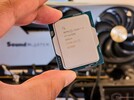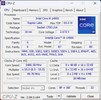Intel Core i7-14700 vs Intel Core i9-14900 vs Intel Core i9-14900K
Intel Core i7-14700
► remove from comparison
The Intel Core i7-14700 is a desktop processor based on the Raptor Lake architecture, which inherits the 13th generation of Intel Core processors with minor improvements. The processor offers a base clock of 1.5 GHz or 2.1 GHz and reaches up to 5.4 GHz in Turbo. The basic CPU structure remains unchanged. The Intel Core i7-14700 features 8 P-cores and 12 E-cores, allowing up to 28 threads to be processed in parallel. It is also based on the LGA 1700 socket, which was already introduced with Alder Lake.
Graphics unit
Like the Intel Core i7-13700K, the Intel Core i7-14700 also has an integrated graphics unit. The Intel Iris Xe architecture continues to serve as the basis. In terms of performance, however, nothing has changed with the Intel UHD Graphics 770.
Power consumption
The TDP of the Intel Core i7-14700 is 65 watts, with the option of consuming up to 219 watts in Turbo mode.
Intel Core i9-14900
► remove from comparison
The Intel Core i9-14900 is a high-end processor based on the Raptor Lake architecture. The base clock is 2 GHz and can reach up to 5.8 GHz under optimal conditions. Similar to the top model (Intel Core i9-14900K), the total of 32 threads are divided into 8 p- and 16 e-cores. The 8 performance cores (p-cores) also offer hyperthreading, which means that a total of 32 threads can be processed simultaneously. The non-K model is an economical processor. There is still the option of DDR4 or DDR5 memory.
Performance
Compared to the Intel Core i9-14900K, the Core i9-14900 offers the same number of physical computing units. However, due to the lower power consumption, the Intel Core i9-14900 delivers slightly less performance. The intended use is primarily for compact PCs with limited cooling options.
Graphics unit
Like the Intel Core i9-14900K, the Intel Core i9-14900 offers an integrated graphics unit. The Intel Iris Xe architecture continues to serve as the basis. In terms of performance, however, nothing has changed with the Intel UHD Graphics 770.
Power consumption
The Intel Core i9-14900 is specified with a TDP of 65 watts, which corresponds to the PL1 value. In boost mode, the processor's performance can increase to up to 219 watts (PL2). However, this requires very good cooling. Compared to the Intel Core i9-13900, the specified power consumption has not changed.
Intel Core i9-14900K
► remove from comparison
The Intel Core i9-14900K is a high-end processor based on the Raptor Lake architecture, similar to the Intel Core i9-13900K last year. The base clock is 3.2 GHz and can reach up to 6 GHz under optimal conditions. The total of 32 threads are still divided into 8 P and 16 E cores. The 8 performance cores (P-cores) also offer hyperthreading, which means that a total of 32 threads can be processed simultaneously in conjunction with the 16 energy-efficient E-cores. As before, the K models continue to offer a freely selectable multiplier, which simplifies overclocking. The Intel Core i9-14900K uses the same CPU socket (LGA 1700) as the Intel Core i9-13900K. This means you don't necessarily need a new motherboard, as the 600 series chipsets support the new processors after a BIOS update. There is also still the option of using DDR4 for the RAM.
Performance
Compared to the Intel Core i9-13900K, the Core i9-14900K still offers 8 P-cores, which are relieved by 16 additional E-cores for demanding applications and thus ensure very high multi-thread performance. In comparison, however, the Intel Core i9-14900K can only gain a slight lead. The e-cores primarily take care of background applications. The hybrid architecture relies on the Intel Thread Director, which is responsible for the correct allocation of tasks. Meanwhile, the IPC could only be increased slightly. As an innovation with the Intel Core i9-14900K, the manufacturer is increasingly relying on AI, which is also used for overclocking. With one click in the Intel Extreme Utility, the tool checks the entire system and makes the necessary settings.
Graphics unit
Like the Intel Core i9-13900K, the Intel Core i9-14900K offers an integrated graphics unit. The Intel Iris Xe architecture continues to serve as the basis. In terms of performance, however, nothing has changed with the Intel UHD Graphics 770.
Power consumption
The Intel Core i9-14900K is specified with a TDP of 125 watts, which corresponds to the PL1 value. In Boost mode, the processor's performance can increase to up to 253 watts (PL2). However, this requires very good cooling. Compared to the Intel Core i9-13900K, the specified power consumption does not increase if the limits are adhered to. The situation is different if the limits are deactivated. As this value depends on the overall system, we cannot make an exact statement on this.
| Model | Intel Core i7-14700 | Intel Core i9-14900 | Intel Core i9-14900K | ||||||||||||||||||||||||||||||||||||||||||||||||||||||||||||||||||||||||||||||||||||
| Codename | Raptor Lake | Raptor Lake | Raptor Lake | ||||||||||||||||||||||||||||||||||||||||||||||||||||||||||||||||||||||||||||||||||||
| Series | Intel Raptor Lake-R | Intel Raptor Lake-R | Intel Raptor Lake-R | ||||||||||||||||||||||||||||||||||||||||||||||||||||||||||||||||||||||||||||||||||||
| Series: Raptor Lake-R Raptor Lake |
|
|
| ||||||||||||||||||||||||||||||||||||||||||||||||||||||||||||||||||||||||||||||||||||
| Clock | 1500 - 5400 MHz | 2000 - 5800 MHz | 3200 - 6000 MHz | ||||||||||||||||||||||||||||||||||||||||||||||||||||||||||||||||||||||||||||||||||||
| L2 Cache | 28 MB | 32 MB | 32 MB | ||||||||||||||||||||||||||||||||||||||||||||||||||||||||||||||||||||||||||||||||||||
| L3 Cache | 33 MB | 36 MB | 36 MB | ||||||||||||||||||||||||||||||||||||||||||||||||||||||||||||||||||||||||||||||||||||
| Cores / Threads | 20 / 28 8 x 5.4 GHz Intel Raptor Cove P-Core 12 x 4.2 GHz Intel Gracemont E-Core | 24 / 32 8 x 5.8 GHz Intel Raptor Cove P-Core 16 x 4.3 GHz Intel Gracemont E-Core | 24 / 32 8 x 6.0 GHz Intel Raptor Cove P-Core 16 x 4.4 GHz Intel Gracemont E-Core | ||||||||||||||||||||||||||||||||||||||||||||||||||||||||||||||||||||||||||||||||||||
| TDP | 65 Watt | 65 Watt | 125 Watt | ||||||||||||||||||||||||||||||||||||||||||||||||||||||||||||||||||||||||||||||||||||
| TDP Turbo PL2 | 219 Watt | 219 Watt | |||||||||||||||||||||||||||||||||||||||||||||||||||||||||||||||||||||||||||||||||||||
| Technology | 10 nm | 10 nm | 10 nm | ||||||||||||||||||||||||||||||||||||||||||||||||||||||||||||||||||||||||||||||||||||
| max. Temp. | 100 °C | 100 °C | 100 °C | ||||||||||||||||||||||||||||||||||||||||||||||||||||||||||||||||||||||||||||||||||||
| Socket | LGA 1700 | LGA 1700 | LGA 1700 | ||||||||||||||||||||||||||||||||||||||||||||||||||||||||||||||||||||||||||||||||||||
| Features | Intel UHD Graphics 770, max. 192 GB of DDR5 5600 MT/s or DDR4 3200 MT/s | Intel UHD Graphics 770, DDR5 5600 MT/s, DDR4 3200 MT/s | |||||||||||||||||||||||||||||||||||||||||||||||||||||||||||||||||||||||||||||||||||||
| iGPU | Intel UHD Graphics 770 (300 - 1600 MHz) | Intel UHD Graphics 770 (300 - 1650 MHz) | Intel UHD Graphics 770 (300 - 1650 MHz) | ||||||||||||||||||||||||||||||||||||||||||||||||||||||||||||||||||||||||||||||||||||
| Architecture | x86 | x86 | x86 | ||||||||||||||||||||||||||||||||||||||||||||||||||||||||||||||||||||||||||||||||||||
| $384 U.S. | $549 U.S. | $589 U.S. | |||||||||||||||||||||||||||||||||||||||||||||||||||||||||||||||||||||||||||||||||||||
| Announced | |||||||||||||||||||||||||||||||||||||||||||||||||||||||||||||||||||||||||||||||||||||||
| Manufacturer | www.intel.com | www.intel.de | ark.intel.com | ||||||||||||||||||||||||||||||||||||||||||||||||||||||||||||||||||||||||||||||||||||
| Die Size | 257 mm2 | 257 mm2 |
Benchmarks
Average Benchmarks Intel Core i7-14700 → 100% n=25
Average Benchmarks Intel Core i9-14900 → 106% n=25
Average Benchmarks Intel Core i9-14900K → 132% n=25
* Smaller numbers mean a higher performance
1 This benchmark is not used for the average calculation













